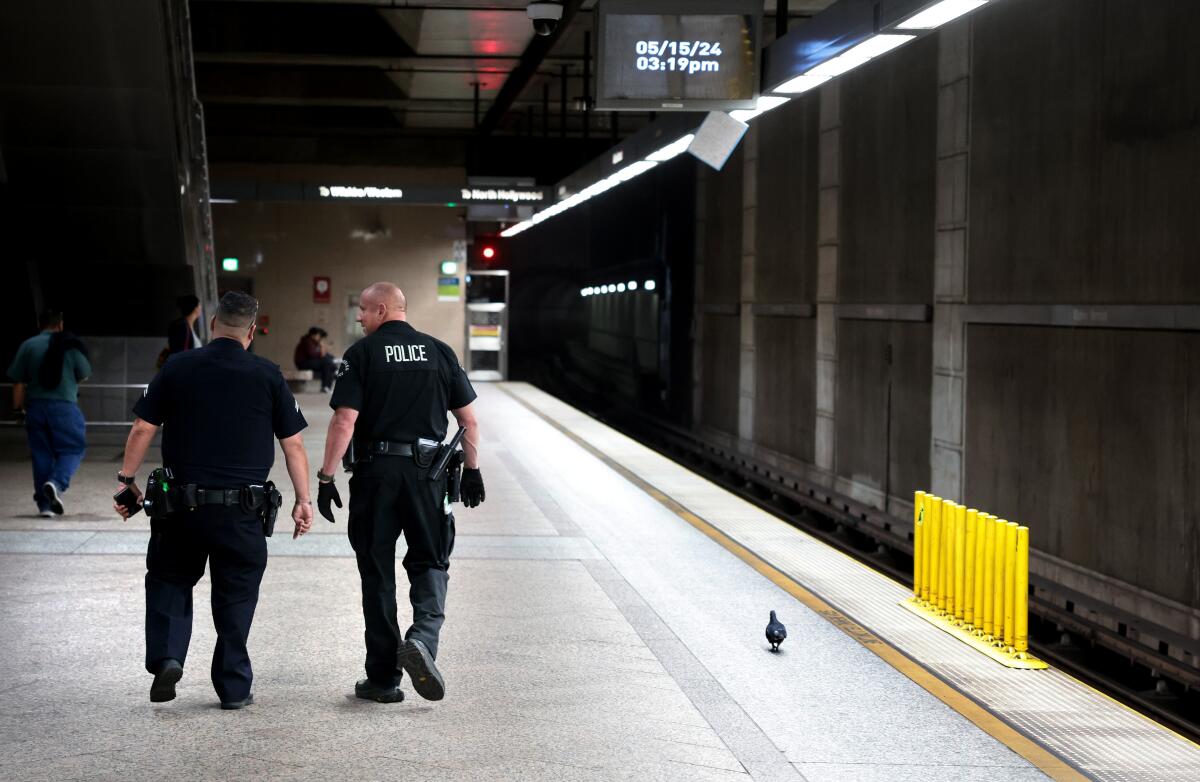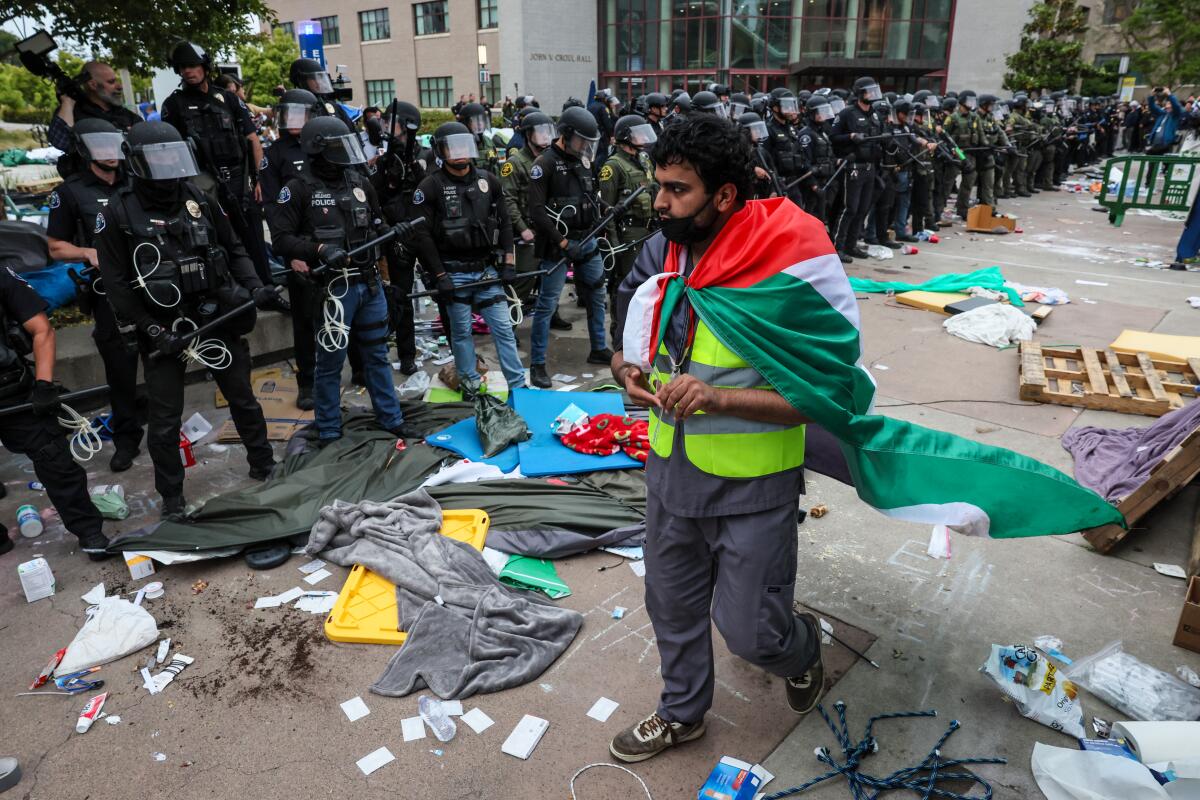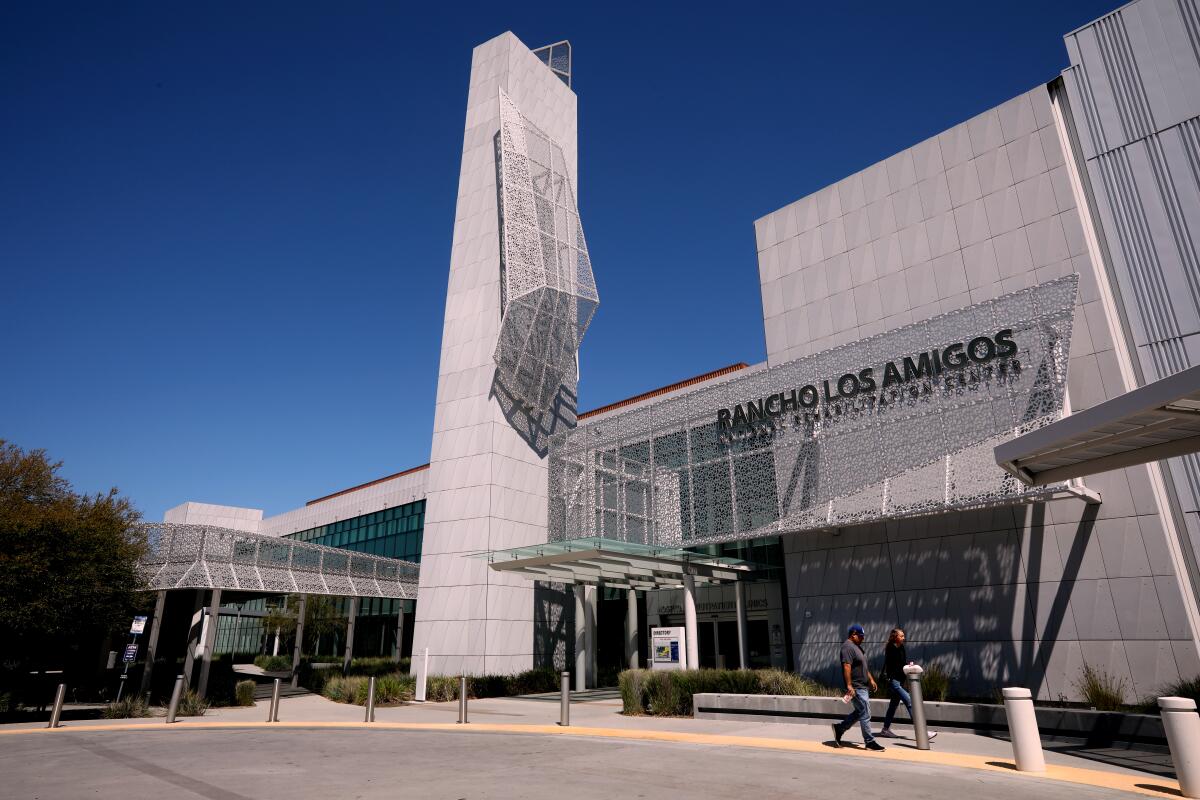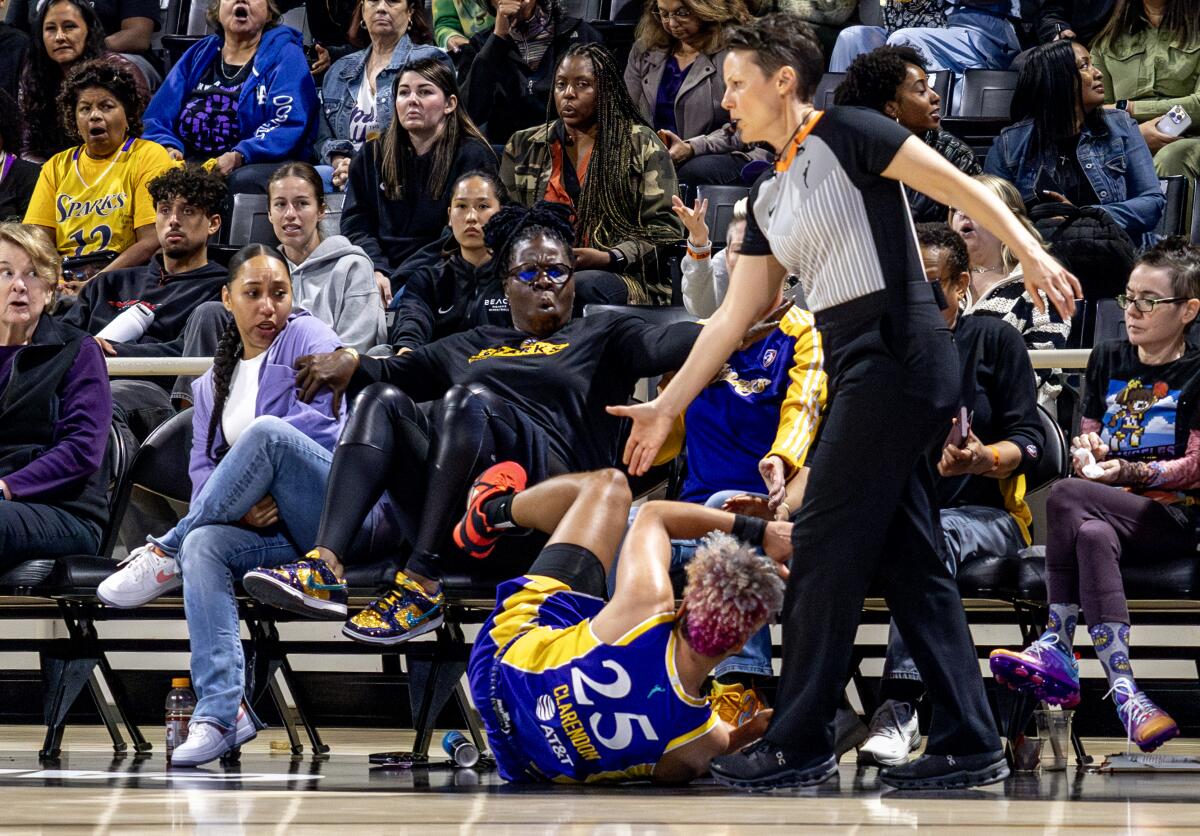A policing surge is coming to L.A. Metro. Critics call it more of the ‘same failed solution’

Good morning. It’s Friday, May 17. Here’s what you need to know to start your day.
- Can more armed policing make L.A.’s transit system safer?
- Police arrest 47 at UC Irvine after sweeping protest camp, clearing barricaded building.
- Twenty of the best happy hour deals in Los Angeles.
- And here’s today’s e-newspaper
You're reading the Essential California newsletter
Our reporters guide you through our biggest news, features and recommendations every morning
You may occasionally receive promotional content from the Los Angeles Times.
Is a policing surge the answer to L.A.’s transit safety concerns?
More armed police and sheriff’s deputies will be visible on Los Angeles County’s buses and trains as agency leaders cite an increase in violent crime on the system.
At a news conference Thursday, L.A. Mayor and Metro board chair Karen Bass said she had directed “an immediate surge of law enforcement personnel on Metro buses, on rail cars and in stations to address this spike.”
Bass also announced an upcoming board motion that would increase law enforcement deployment throughout the transit system.
It’s not yet known how much the agency will pay for the increased deployments — or how many more officers would be deployed. The surge would amount to “a minimum of dozens [more officers] per day,” according to Metro spokesperson Dave Sotero, who added that Metro’s contracted law enforcement agencies are developing cost estimates.
Metro has paid about $1 billion since 2017 to the Los Angeles Police Department, the L.A. County Sheriff’s Department and the Long Beach Police Department. Tensions have risen during that time, with Metro officials considering creating their own transit police force, citing high costs and not enough improvements to safety.
The action from Bass and Metro leaders comes during “a near daily barrage of new attacks on passengers and drivers,” L.A. Times transportation and mobility reporter Rachel Uranga explained.
“Three people were stabbed in two separate incidents earlier this week,” she reported. “Last month, Mirna Soza, 66, was fatally stabbed on the subway as she came home from her night shift job and a passenger captured a bus driver pleading for help after being stabbed. The list goes on.”
What do the numbers show?
According to the latest figures, violent and property crimes are trending downward overall in recent months — and ridership on the transit system continues to increase year-over-year after the sharp COVID-19 pandemic dip.
Metro published its latest safety report Thursday showing that violent crime fell nearly 35% between March 2023 and March 2024. The agency has not yet analyzed figures for April or May.
The agency also tracks “Crimes against Society,” which include trespassing, drug use and possession of illegal weapons. Crimes in this category have jumped more than 160% in that same March-to-March time period, which Metro officials say is a result of increased arrests from law enforcement patrolling the system in recent months.
Though the data show that the total number of violent crimes and the share of riders who become victims of those crimes are decreasing, contextual crime statistics just don’t hit the same as news stories about violence on the transit system.
It’s also worth noting that, in terms of the risks of bodily injury or death, taking public transit is magnitudes safer than walking or driving on L.A. County streets, where more than 4,700 people were killed or seriously injured on average over the last five years.
Who’s responsible for safety concerns?
Even as Metro’s leaders voiced support for a boosted law enforcement presence on the system they manage, some made efforts to shift blame away from the agency.
CEO Stephanie Wiggins pointed to data showing that “untreated mental illness and drug addiction are contributing factors to many of the recent unprovoked attacks on our system.”
“Metro is a transit agency — not a social services agency,” she added.
Board member and county Supervisor Kathryn Barger said it feels as if Metro is “fighting an uphill battle” in the face of a growing mental health crisis.
“Much of this is a symptom of the dysfunction and failure of government … including at the federal and state levels, that spill over onto our transportation system,” she said.
L.A. County Supervisor and L.A. Metro board member Janice Hahn said that despite the hundreds of millions L.A. Metro has paid to law enforcement agencies, they are not doing enough.
“For too long, these contracts have not gotten us a readily visible law enforcement presence on our system,” Hahn said. “We need law enforcement officers riding our buses and our trains — it does not do our riders any good if officers remain in their squad cars.”
Hahn’s characterization echoes the findings of a two-year audit of law enforcement performance by Metro’s Office of the Inspector General. That report found the contracted agencies lacked monitoring and oversight to verify if the personnel assigned to patrol the transit system were actually doing so.
For instance, the audit states that in the 2021 and 2022 fiscal years, officers from the LAPD’s Transit Services Division (the division Metro contracts with) responded to fewer than half of the incidents or calls for service on Metro’s system in the LAPD service area. The majority of incidents were handled by neighborhood LAPD patrol units, according to the report.
The audit also found that the majority of LASD personnel patrolling their region were assigned to patrol cars as opposed to walking stations or riding buses and trains.
In a board committee meeting last March, Metro’s then-Chief Safety Officer Gina Osborn was asked about how law enforcement contractors responded to criticism about a lack of patrols on the system. Her reply:
“I was told they weren’t going to have a bus company tell them how to deploy their resources.”
Osborn was fired by Wiggins this March after she filed a report with the agency’s inspector general’s office.
Criticism from transit advocates
This latest round of safety concerns is a snapshot of an ongoing tug-of-war between perception of crime and actual crime.
That tension often results in political leaders opting for a show of force. But critics of L.A. Metro’s policing policies say the formula of more armed officers equals more safety is flawed.
“More cops has not made us safer,” said Scarlett De Leon, campaigns director for the Alliance for Community Transit-Los Angeles (ACT-LA). “It’s just throwing money at the same failed solution of law enforcement … and it’s really a disappointment.
ACT-LA is a coalition of community organizations calling for more affordable housing and better access to public transit, which members say will improve public health and economic mobility for the region’s communities of color.
“While violent incidents on Metro have been decreasing and public transit remains far safer than car travel, all riders deserve to feel safe and comfortable on the system,” coalition officials wrote in a statement.
ACT-LA is demanding that L.A. Metro rely less on armed policing and instead “address root issues by investing in health and safety strategies that work.”
De Leon pointed to Metro’s transit ambassadors, the hundreds of unarmed, green-shirted staff members who walk stations and ride trains and buses, offering help to riders. More than 60% of riders surveyed last year said they felt safer on Metro trains because of the ambassadors.
She also said the agency should be boosting its outreach programs that aim to help people experiencing homelessness and mental illness.
“Metro is a microcosm of what’s going on in the city and the county, whether they created it or not,” De Leon told me. “Metro is a public agency … they’re here to serve the community. And this is what the community needs.”
Today’s top stories

Campus protests heat up again
- UC Irvine protest: Newport Beach mayor claps back at Irvine mayor’s tweet over “violent scenario.”
- Police arrest 47 at UC Irvine after sweeping protest camp, clearing barricaded building.
- Sonoma State president put on leave for “insubordination’” for supporting Israel academic boycott, divestment.
- “Maximize chaos.” UC academic workers authorize a strike, alleging rights violated during protests.
Newsom in Vatican City
- Gov. Gavin Newsom, during his speech at the Vatican on climate change, accuses Trump of “open corruption.”
- Climate change is central to both Pope Francis and Newsom. But do Catholic voters care?
101 best West Coast experiences
- From Baja to British Columbia, these are the 101 best West Coast experiences.
- Take an epic trip along the West Coast in 2024. Here are the top 10 places to visit now.
- Tell us: What’s the most extraordinary West Coast experience?
- Buy a copy of the new “West Coast 101” zine.
Climate and environment
- Newsom administration unveils a new $20-billion cost estimate for delta water tunnel.
- As national wastewater testing expands, Texas researchers identify bird flu in nine cities.
- A California tribe was twice robbed of its land. A 77-acre purchase brings hope.
- As salmon populations struggle, California bans fishing on rivers for a second year.
- Cloudy with a chance of rage: Climatologists fume over relocation of L.A. weather station.
More big stories
- Migrants from around the world have made this stretch of California the top place to enter the U.S. illegally.
- California public school enrollment drops again, but transitional kindergarten is up.
- Former Sheriff Villanueva to file $25-million lawsuit over county’s “Do Not Rehire” label.
- The new Disney, Warner and Fox sports steaming joint venture finally has a name.
- The Supreme Court rejects payday lenders’ challenge to Obama-era consumer protection bureau.
- A star USC scientist faces scrutiny — retracted papers and a paused drug trial.
- A year after its Tony boost, Pasadena Playhouse unveils 2024-25 season.
- SoCal district to pay $360K to teacher who was fired after refusing to follow transgender policies.
- A woman was dragged by a self-driving Cruise taxi in San Francisco. The company is paying her millions.
- California is changing how big power companies charge for electricity. What to expect on your bill.
- Rebecca Grossman and a top D.A. advisor shouldn’t have the same lawyer, prosecutors argue.
- A UPS driver was fatally shot while sitting in a parked van, Irvine police say.
- Massive budget cuts leave California domestic violence survivors with few options.
- SoCal parks agency fines visitors who roll through stop signs $100. It has made millions.
- A California psychedelics bill that would bring ‘magic mushrooms’ into the mainstream fails – again.
Get unlimited access to the Los Angeles Times. Subscribe here.
Commentary and opinions
- Editorial: China embraced electric vehicles. The U.S. didn’t. Now we’re paying the price.
- Sammy Roth: Meet the comedians telling hilarious jokes about climate change.
- Steve Lopez: At Homeboy, the scoop on Father Greg and his latest honor, from those who know him best.
- Editorial: Critics say Proposition 28 arts funding is being misspent. School administrators need to show their work.
Today’s great reads
This anesthesiologist is L.A. County’s highest-paid employee. He works 94 hours a week. Dr. Sebo Amirkhanian Namagerdy, an anesthesiologist at Rancho Los Amigos, earned $1.26 million in 2023. His sky-high salary stems from a heavy workload — an average of 94 hours a week.
Other great reads
- How YouTube became must-see TV: Shorts, sports and Coachella livestreams.
- Cannes: “Fury Road” prequel “Furiosa” forgets what makes the “Mad Max” movies great.
How can we make this newsletter more useful? Send comments to [email protected].
For your downtime

Going out
- 🍻Twenty of the best happy hour deals in Los Angeles.
- 🔭 A guide to dreamy stargazing adventures in L.A. and beyond.
- 🌼 Check out this under-the-radar wildflower spot while you still can.
Staying in
- 📺 The 14 TV shows we’re most excited for this summer.
- 🧑🍳 Here’s a recipe for salt-and-pepper pork chops with vinegared scallions.
- ✏️ Get our free daily crossword puzzle, sudoku, word search and arcade games.
And finally ... a great photo
Show us your favorite place in California! We’re running low on submissions. Send us photos that scream California and we may feature them in an edition of Essential California.
Today’s great photo is from Times photographer Gina Ferazzi. She captured comedian Leslie Jones avoiding a collision with Sparks guard Layshia Clarendon on Wednesday night.
Have a great day, from the Essential California team
Ryan Fonseca, reporter
Kevinisha Walker, multiplatform editor and Saturday reporter
Christian Orozco, assistant editor
Karim Doumar, head of newsletters
Check our top stories, topics and the latest articles on latimes.com.
Sign up for Essential California
The most important California stories and recommendations in your inbox every morning.
You may occasionally receive promotional content from the Los Angeles Times.





